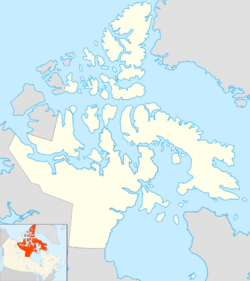Harper Islands facts for kids
| Geography | |
|---|---|
| Location | Frobisher Bay |
| Coordinates | 62°20′59″N 064°40′00″W / 62.34972°N 64.66667°W |
| Archipelago | Canadian Arctic Archipelago |
| Administration | |
|
Canada
|
|
| Nunavut | Nunavut |
| Region | Qikiqtaaluk |
| Demographics | |
| Population | Uninhabited |
| Source: Harper Islands at the Atlas of Canada | |
The Harper Islands are a small group of islands in Canada. They are located in the territory of Nunavut, which is a large area in northern Canada. These islands are part of a bigger group called the Baffin Island group.
The Harper Islands cover an area of about 8 square kilometers. This is roughly the size of 800 football fields! No people live on the Harper Islands, which means they are completely uninhabited.
Contents
Where Are the Harper Islands?
The Harper Islands are found in a very interesting place. They are located where Frobisher Bay meets the Labrador Sea. Frobisher Bay is a large inlet of the Labrador Sea, and it's named after an English explorer, Martin Frobisher. The Labrador Sea is part of the Atlantic Ocean.
Part of the Canadian Arctic
These islands are also part of the Canadian Arctic Archipelago. This is a huge group of islands in the Arctic region of Canada. It includes many large and small islands. The Harper Islands are quite far north, in a cold and icy environment.
Nearby Islands
There are other islands close to the Harper Islands. These include Lefferts, Bear, Little Hall, and Hudson islands. They are all found near the tip of a land area called the Hall Peninsula.
Life on Arctic Islands
Even though the Harper Islands are uninhabited by people, they are still home to wildlife. Arctic islands like these often have unique plants and animals.
Arctic Environment
The weather on these islands is very cold for most of the year. There is a lot of ice and snow. During the short summer, some plants like mosses, lichens, and small flowers can grow. These plants are very tough and can survive in harsh conditions.
Wildlife
Animals that live in the Arctic are well-adapted to the cold. You might find animals like polar bears, seals, and various types of birds in the wider Arctic region. While specific animals on the Harper Islands are not detailed, they would be part of this Arctic ecosystem. Birds often nest on these remote islands during the warmer months.



